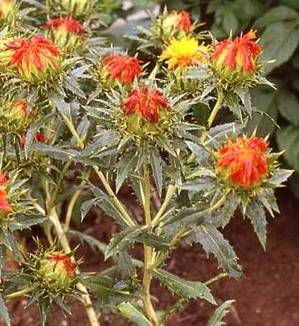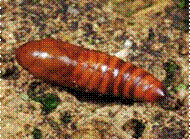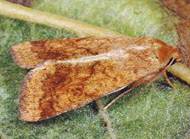Crop Protection :: Oil Seeds :: Pest of Safflower
Important pests of Safflower
Scientific name: tinctorius Family:Compositae
| 1. Gram pod borer/ Capsule borer: Helicoverpa armigera |
Symptoms of damage
- In early stage of crop growth larvae feed on leaves and shoot apices.
- Later, the larvae shift to the developing capitula.
- The symptoms are perforated leaves, perforated involucral bracts, partially or completely eaten capitula in the bud stage and bored developing capitula.
Identification of the pest
- Eggs: Spherical in shape and creamy white in colour, laid singly
- Larva: Shows colour variation from greenish to brown. It has dark brown grey lines on the body with lateral white lines and also has dark and pale bands.
- Pupa: Brown in colour, occurs in soil, leaf, pod and crop debris
Adult
- Light pale brownish yellow stout moth.
- Forewings are olive green to pale brown with a dark brown circular spot in the centre.
- Hind wings are pale smoky white with a broad blackish outer margin
|
|
Management
- Intercropping with non host crop like wheat or barley.
- Avoid chickpea as intercrop.
- Excessive application of nitrogen should be avoided.
- Ha NPV can be applied at 250-300 larval equivalents/ha.
- Conserve Campoletis chloridae, Enicospilus sp, etc.
- Spray monochrotophos 750 ml/ha in 600-800 litres of water per hectare.
|
|
| 2. Safflower caterpillar: Perigaea capensis . |
Symptoms of damage
- The larva feeds on the leaves and sometimes on capitulum too.
- It also feeds on bracts, flowers, capsules.
|
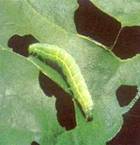 |
Identification of the pest
- Larva: Stout, green and smooth. The anal segment is humped and the body has some purple markings.
- Adult - Dark brown in colour, medium sized moth on; Forewings are dark brown with pale wavy marks; Hind wings are light brown
|
Management
- Intercropping with non-host crop like wheat.
- Excessive application of nitrogen should be avoided.
- Spraying of carbaryl 50 WP@ 2.5 - 3.00 kg/ha or fenvalerate 20 EC @ 250 ml/ha.
|
|
| 3. Capsule fly/Safflower bud fly: Acanthiophilus helianthi rossi |
Symptoms of damage
- Newly hatched larvae feed on the soft parts of the capsules
- Affected buds show small bore holes
- The infested buds rotten with a foul smelling ooze coming out of the apices
Identification of the pest
- Larva: Maggot is dirty white in colour
- Adult: Flies are ash coloured with light brown legs.
|
Management
- Application of dimethoate 30 EC @ 600-650 ml/ha or malathion 50 EC @ 1.00 litre/ha or phosphomidon 100 EC@ 150-200 ml/ha. About 600 to 650 litre of water is needed for spraying in about one hectare area.
|
|
| 4. Safflower aphid: Uroleucon carthami |
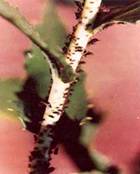
|
Symptoms of damage
- Curling and yellowing of tender leaves
- Secrete honey dew like secretion on upper surface of the leaves and plant parts forming a black sooty mold which hinders photosynthetic activity resulting in stunted growth
- Finally the plants dry up.
|
Identification of the pest
- Nymphs - Reddish brown. Adults - Large sized, black with pear-shaped body and conspicuous cornicles.
|
Management
- Avoid late sowing.
- If the attack is observed in the border rows take control measures.
- Avoid excess use of nitrogen.
- Maintain 2 or 3 rows of Maize and Sorghum around the fields.
- Release of Chrysoperla eggs/grubs @ 1-2/plant.
- Conserve Aphidencyrtus aphidivorus, Micromus cinearis, Ischiodon scutellaris, Harmonia octomaculat and Aphelinus sp
- Spray dimethoate 30 EC @ 750 ml/ha,40 and 60 days after sowing or monochrotophos 0.05%. Use 500 litres of spray mixture and 20 kg dust formulation/ ha.
|
|
|

